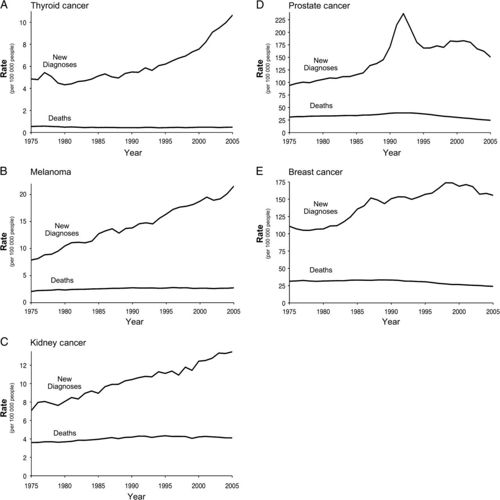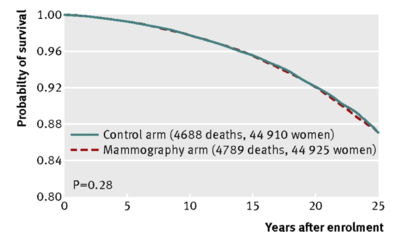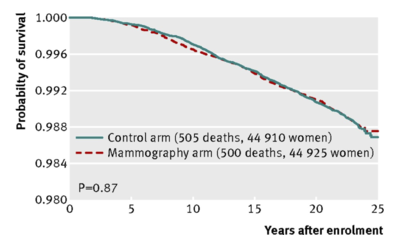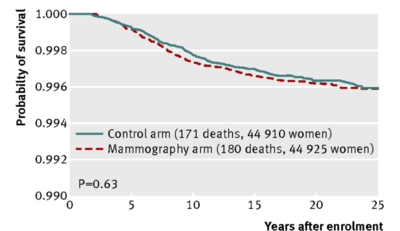Chance News 98: Difference between revisions
| Line 80: | Line 80: | ||
<center> | <center> | ||
[[File:F2_BCmortality.png | 400px]] | [[File:F2_BCmortality.png | 400px]] | ||
'''Fig 2 All cause mortality, by assignment to mammography or control arms (all participants)''' | |||
</center> | </center> | ||
<br> | <br> | ||
<center> | <center> | ||
[[File:F3_BCspecific.png | 400px]] | [[File:F3_BCspecific.png | 400px]] | ||
'''Fig 3 Breast cancer specific mortality, by assignment to mammography or control arms (all participants)''' | |||
</center> | </center> | ||
<br> | <br> | ||
<center> | <center> | ||
[[File:F4_BCdiagnosis.png | 400px]] | [[File:F4_BCdiagnosis.png | 400px]] | ||
'''Fig 4 Breast cancer specific mortality from cancers diagnosed in screening period, by assignment to mammography or control arms''' | |||
</center> | </center> | ||
This very large--a sample size of approximately 90,000-- 25 year randomized control trial concludes that | This very large--a sample size of approximately 90,000-- 25 year randomized control trial concludes that | ||
Revision as of 19:00, 27 February 2014
Quotations
"In statistics it's enough for our results to be cool. In psychology they're supposed to be correct. In economics they're supposed to be correct and consistent with your ideology."
Some other selections:
- “God created the world in 7 days and we haven’t seen much of him since.” (God draws θ from an urn and then is out of the picture)
- “People don’t go around introducing you to their ex-wives.” (why model improvement doesn’t make it into papers)
Submitted by Paul Alper
"In our lust for measurement, we frequently measure that which we can rather than that which we wish to measure...and forget that there is a difference."
“Statistics and Experimentation”, AP Statistics Reading, June 16, 2011
"'We value what we measure rather than measuring what we value' is an expression commonly heard in education circles these days."
Submitted by Margaret Cibes
From What the Numbers Say, by Niederman and Boyum, 2003:
“Unfortunately, Americans seem much better at producing numbers than making sense of them.” [p. 1]
“Distrusting numbers is not the same as disregarding them.” [p. 11]
“[G]ive more credence to a finding if there is good reason to believe it for reasons other than its statistical significance.” [p. 219]
“Elizabeth Taylor’s Law (the marital version of Pareto’s Law) reminds us that a small fraction of the population accounts for a disproportionate share of divorces.” [p. 17]
“[M]ost people not only lack a notation for dealing with small numbers, they also lack a vocabulary. If you show a man the number 3,500,000 and ask what it is, he will say, with little if any hesitation, ‘three and a half million’ … or ‘three million five hundred thousand.’ But if you show him 0.00000029, he will probably respond, ‘point oh oh oh oh oh oh two nine,’ slowly …. [J]ust imagine a politician describing the defense budget as ‘three six nine oh oh oh oh oh oh oh oh oh dollars.” [pp. 117-118]
Submitted by Margaret Cibes
Forsooth
A Google search for “apophenia” yielded the following:
(a) “the experience of seeing patterns or connections in random or meaningless data.”
(b) “an example of a Type I error … – the identification of false patterns in data.”
(c) “heavily documented as a source of rationale behind gambling, with gamblers imagining they see patterns in the occurrence of numbers in lotteries, roulette wheels, and even cards.”
(d) “an open statistical library for working with data sets and statistical models. It provides functions on the same level as those of the typical stats package … but gives the user more flexibility to be creative in model-building.” [emphasis added]
Submitted by Margaret Cibes
From What the Numbers Say, by Niederman and Boyum, 2003:
“Out there, just in our galaxy alone, there are 400 billion stars. If only one out of a million of those had planets, and if just one of a million of those had life, and if just one out of a million of those had intelligent life, there would be literally millions of civilizations out there.” [citing film Contact, pp. 105-106]
“Ninety-nine times out of 10 you’re not going to win like that.” [citing USAF Academy football coach Fisher DeBerry, p. 172]
“In 1998 there were 361 fatal accidents out of 39 million flights. The ‘risk’ of a fatal accident is only 0.000009 percent.” [citing letter defending airline safety, p. 172]
Submitted by Margaret Cibes
Some frightening graphs
Most people believe that
- Unless treated, cancer is necessarily fatal; and
- The earlier cancer is diagnosed and treated, the more likely the cure
Because cancer is a catchall term, #1 is certainly wrong. Some cancers grow so slowly that death is due to another cause. Indeed, some cancers are so indolent that a person may lead an entire life unaware even of the existence of the cancer. Therefore, in spite of its plausibility, #2 is suspect because diagnoses based on a screening test might lead to unnecessary and harmful treatments.
The following five graphs found in an article by Welch and Black illustrate this conundrum of modern medicine: it can do a great deal of harm precisely because it is so good at doing things such as finding abnormalities which represent non-threatening deviations from what is deemed normal.

Notice that for each of the five cancers, its time series of mortality is flat whereas the number of new diagnoses rises prohibitively over time indicating overdiagnosis and therefore, overtreatment with consequent suffering. As another instance of overdiagnosis, overtreatment and consequent suffering, the following three figures are taken from an article by Miller, et al, in the British Medical Journal (BMJ 2014;348:g366 doi: 10.1136/bmj.g366), entitled “Twenty five year follow-up for breast cancer incidence and mortality of the Canadian National Breast Screening Study: randomised screening trial.”
Fig 2 All cause mortality, by assignment to mammography or control arms (all participants)
Fig 3 Breast cancer specific mortality, by assignment to mammography or control arms (all participants)
Fig 4 Breast cancer specific mortality from cancers diagnosed in screening period, by assignment to mammography or control arms
This very large--a sample size of approximately 90,000-- 25 year randomized control trial concludes that
Annual mammography in women aged 40-59 does not reduce mortality from breast cancer beyond that of physical examination or usual care when adjuvant therapy for breast cancer is freely available. Overall, 22% (106/484) of screen detected invasive breast cancers were over-diagnosed, representing one over-diagnosed breast cancer for every 424 women who received mammography screening in the trial.
Discussion
1. With regard to the five time series, suppose instead of overdiagnosis and overtreatment, the following (reverse causality) argument is made: despite the rise in each of the cancers, modern medicine has kept the mortality constant. Comment on this assertion.
2. Notice that in the above Figs 2, 3 and 4, a p-value is given for the comparison between the mammography arm and the control arm. Looking at the curves themselves, comment as to why it makes sense that each of the p-values is well above the mystical .05.
3. With regard to the mammography study, there is an accompanying editorial in the BMJ entitled “Too much mammography.” This editorial goes on to compare and contrast PSA screening with mammography. Although PSA screening and mammography seem to be very similar "owing to [the] small effect on mortality and large risk of overdiagnosis ([1]),"
Nevertheless, the UK National Screening Committee does recommend mammography screening for breast cancer but not prostate specific antigen screening for prostate cancer.
Because the scientific rationale to recommend screening or not does not differ noticeably between breast and prostate cancer, political pressure and beliefs might have a role.
We agree with Miller and colleagues that “the rationale for screening by mammography be urgently reassessed by policy makers.” As time goes by we do indeed need more efficient mechanisms to reconsider priorities and recommendations for mammography screening and other medical interventions. This is not an easy task, because governments, research funders, scientists, and medical practitioners may have vested interests in continuing activities that are well established.
Comment on the vested interests and why the task is difficult.
4. Although the study by Miller is in some sense a bombshell, note that evidence has existed for over 10 years previous that mammography screening for women under 60 years of age had severe problems.
Our finding of increased mastectomies has consistently been ignored by screening advocates for 10 years, and information from many cancer charities and governmental agencies continues to state the opposite – that screening decreases mastectomies - despite having no reliable data to support this claim.
As another instance of a (personal) vested interest, and to show how difficult it is to discuss the problems of mammography screening as seen by evidence based medicine, diplomatically engage a female and bring up the topic.
5. This is a link to a presentation given by Dr. H. Gilbert Welch a few years ago and thus, does not include the Miller Canadian study mentioned above. The video is 99 minutes in length but well worth seeing in its entirety. He discusses the five time series at length and he illustrates the deficiencies of mammography as was known then.
Submitted by Paul Alper
Knuth and sports statistics
On the Isolated Statisticians list, Albyn Jones shared a link he received to a short YouTube video entitled The Electronic Coach. It features the famous computer scientist Donald Knuth as a student in the 1950s, using computer analysis (punch cards and all!) to help his college's basketball team.
The whole and its parts
The full-fat paradox: Whole milk may keep us lean
by Allison Aubrey, NPR "Morning Edition", 12 February 2014
According to Aubey
The reason we're told to limit dairy fat seems pretty straightforward. The extra calories packed into the fat are bad for our waistlines — that's the assumption.
But what if dairy fat isn't the dietary demon we've been led to believe it is? New research suggests we may want to look anew.
In one study published by Swedish researchers in the Scandinavian Journal of Primary Health Care, middle-aged men who consumed high-fat milk, butter and cream were significantly less likely to become obese over a period of 12 years compared with men who never or rarely ate high-fat dairy.
Yep, that's right. The butter and whole-milk eaters did better at keeping the pounds off.
The study itself “followed a cohort of rural men over 12 years” because “In a previous study we found that daily intake of fruit and vegetables in combination with a high dairy fat intake was associated with a lower risk of coronary heart disease”:
1782 men (farmers and non-farmers) aged 40–60 years at baseline participated in a baseline survey (participation rate 76%) and 1589 men participated at the follow-up. 116 men with central obesity at baseline were excluded from the analyses.
Central obesity was defined as waist hip ratio ≥ 1. Waist and hip measurements were taken at both surveys with a tape measure at the level of the umbilicus and at the widest part of the hips with the participants dressed in light wear.
The conclusion drawn is
We found that a low intake of dairy fat was associated with a higher risk of developing central obesity and that a high intake of dairy fat was associated with a lower risk of central obesity among men without central obesity at baseline. The majority of the participants were overweight or obese as defined by BMI at baseline. However, the associations between dairy fat intake and central obesity were consistent across BMI categories at baseline.
The table below is reproduced from Table III in the original paper. It indicates that regardless of which model is used, on average, high fat participants have a < 1 waist hip ratio while on average, low fat participants have > 1 waist hip ratio.
Risk of central obesity (waist hip ratio ≥ 1) at follow-up according to dairy fat intake at baseline.
Only men with waist hip ratio < 1 at baseline were included.
Dairy fat intake |
Crude (n = 1,303) OR3 (95% CI) |
Model 11 (n = 1285) OR3 (95% CI) |
Model 12 (n = 1261) OR3 (95% CI) |
| Low (no butter and low fat milk and seldom/never whipping cream) |
1.40 (0.97–2.03) | 1.45 (0.99–2.11) | 1.53 (1.05–2.24) |
| Medium (all other combinations of spread, milk, and whipping cream) |
1 | 1 | 1 |
| High (butter and high fat milk and whipping cream daily or several times a week) |
0.53 (0.34–0.83) | 0.50 (0.31–0.80) | 0.52 (0.33–0.83) |
1Adjusted for fruit and vegetables daily, smoking, alcohol consumption, and physical activity.
2Adjusted as above plus age, education, and profession.
3Odds ratio with 95% confidence intervals.
Discussion
1. This Swedish study is clearly not a randomized clinical trial and depends in some manner on self reporting. Why is this a problem? Why is any inference to a larger population also a problem?
2. This Swedish study has males only included. How does this limit any inference?
3. “Cheese and yoghurt for example were not included/not asked about, nor the vast list of processed dairy products available in the supermarkets of today.” What effect if any might there be because of the exclusion of cheese, yoghurt and other processed dairy products?
4. According to Aubrey, there exists a second study, published in the European Journal of Nutrition, which
is a meta-analysis of 16 observational studies. There has been a hypothesis that high-fat dairy foods contribute to obesity and heart disease risk, but the reviewers concluded that the evidence does not support this hypothesis. In fact, the reviewers found that in most of the studies, high-fat dairy was associated with a lower risk of obesity.
"We continue to see more and more data coming out [finding that] consumption of whole-milk dairy products is associated with reduced body fat," says the executive vice president of the National Dairy Council.
Aubrey suggests “the satiety factor. The higher levels of fat in whole milk products may make us feel fuller, faster. And as a result, the thinking goes, we may end up eating less.” She further adds
As we reported last year, a study of children published in the Archives Of Diseases in Childhood, a sister publication of the British Medical Journal, concluded that low-fat milk was associated with more weight gain over time.
5. Consider “the satiety factor”--full fat keeps us lean--mentioned above. What sort of analogy might there be to gun ownership and safety? Excellent brakes and auto accidents? A GPS system and getting lost?
Submitted by Paul Alper


